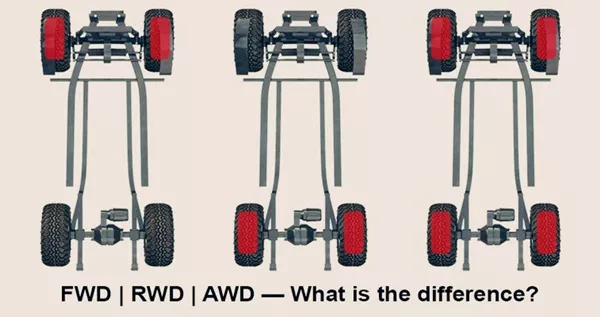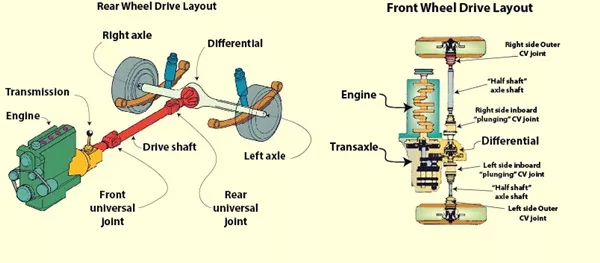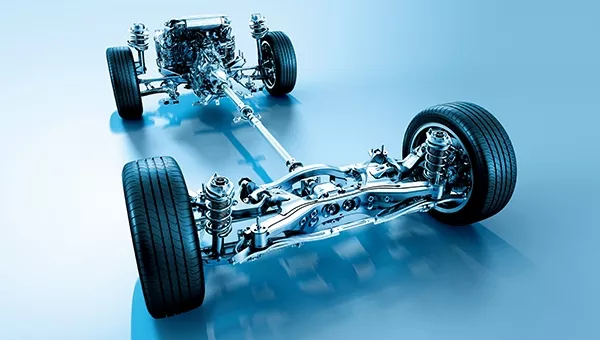Many drivers are unfamiliar with the technical aspects of these three configurations. Even veteran drivers need to know which is better between the front wheel, rear wheel or all-wheel drive to make up for their handling differences.
These powertrains have peculiar traits that can be exploited, as well as negative aspects drivers need to compensate for in daily driving.
Philkotse.com will explain the difference between these three configurations, to help drivers understand their cars better and how to take advantage of their respective attributes in various situations.

Front Wheel, Rear Wheel or All-Wheel drive: Which is better?
I. Front wheel drive (FWD)
Most production cars today use front-wheel drive. This kind of power train is less complex to implement and does not cost much since all the power is transferred directly to the front axle of the car.
This also provides a measure of safety for when the car loses grip since the weight is concentrated on the front-end of the car, aiding traction.
1. Pros
- Less expensive to equip than rear-wheel drive, so most car makers make this the default option except for mid and full-sized SUVs.
- Reduces weight, since there would be no need to install a drive shaft leading to the rear axle as well as a transmission tunnel.
- Cars with FWD accelerate with less effort compared to RWD, using less fuel and resulting in better fuel economy.
- Newbie drivers generally find it easier to drive FWD cars than RWD cars.
- Increased weight at the front aids in control, especially in poor traction conditions.

New drivers find it easier to drive an FWD car
2. Cons
- Since the driveshaft and the transmission are compressed into a single unit, maintenance is a bit more complicated.
- FWD cars are more prone to torque steer, due to the uneven driveshaft lengths between the left and right front wheels. The car will tend to veer either to the left or to the right, especially under hard acceleration, and drivers with insufficient skill may not able to compensate.
- The tires and front suspension components on FWD drive cars tend to wear out much faster since the front wheels do double duty in both steering and propelling the car forward.
FWD vs RWD vs AWD: Know How to Handle Your Junk!
II. Rear wheel drive (RWD)
This is the first drive configuration used in the beginnings of the automobile. Compared to FWD cars, RWD can handle more horsepower and torque., which is why it is used on pickups, SUVs, and high-performance vehicles as standard equipment.
The cost of implementing RWD is a bit more expensive, however, and these days it is only reserved for utility vehicles such as trucks and SUVs. Some tuners prefer to use RWD cars as the canvas for their modifications, in much the same way that muscle cars and other performance cars are used.

Rear Wheel Drive or Front Wheel Drive?
>>> Worth to note: 4 simple methods to tell if a car is a front-wheel drive or rear-wheel drive
1. Pros
- Best suited for dry weather with better handling than front-wheel-drive, much preferred by experienced drivers.
- RWD cars are not as prone to experiencing torque steer since the engine is disengaged from the steering mechanism.
- The vehicle’s weight is more evenly distributed across the vehicle (engine in front, trans-axle at the rear), resulting in more balanced handling.
- RWD cars are more robust and the front suspension doesn’t need to be fixed as often.

RWD car is less fuel-efficient compared to FWD
2. Cons
- Since RWD uses more components, it contributes more weight to the car, consequently becoming less fuel-efficient.
- Some drivers find that RWD is less intuitive than FWD, making it difficult to master in terms of driving dynamics.
- Due to the higher amount of materials involved, RWD cars are a bit more expensive to assemble and market.
- RWD sedans have less interior space since the extra driveline components take up more room.
III. All-Wheel-Drive (AWD)
Similar to four-wheel drive (4WD), AWD comes in both part-time and full-time configurations, such as those equipped in crossovers, SUVs, as well as cars for improved traction on any road surface.
AWD distributes power to all four wheels, using sophisticated sensors to focus that power to where it is needed most in reduced traction situations.

AWD drivetrains are found in premium cars like sports cars, sports sedans, cross-overs, and SUVs
>>> Read more: Top 5 best AWD cars for the money in the Philippines
1. Pros
- Improved traction and power with all wheels spinning to pull ahead. AWD results in better handling across a variety of road surfaces.
- The extra weight of the AWD components makes it heavier and more stable too!
- At high speeds, AWD is easier to control with less likelihood of spinouts.
- Overall handling on dry surfaces is best, providing full contact for better traction and control.
2. Cons
- AWD-equipped cars are more expensive than regular car models.
- Fuel economy suffers the most in AWD cars, compared to those with RWD and FWD.
- AWD is also the most difficult to maintain because of complexity.
Which is better between the front wheel, rear wheel, or all-wheel drive? All of them have particular strengths to offer; it all boils down to which configuration has the most advantages you can live with.
Don’t forget to visit Philkotse.com for helpful tips & advice for car owners!
Recent posts
- Engine configurations: A comprehensive guide to different engine layouts Jan 19, 2021
- Facts to know about 4WD cars before bringing one home Sep 20, 2021
- The ins & outs of car transmission and drivetrain Jan 31, 2019
- 4WD vs AWD: Getting a grip on the road Sep 20, 2021












